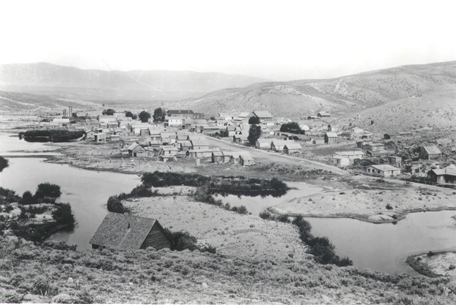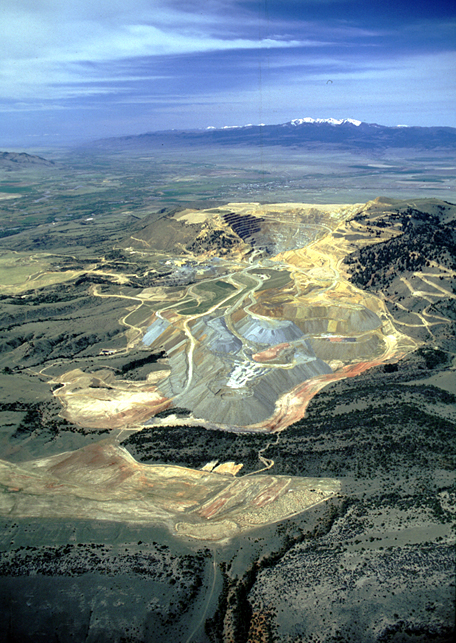Placer Mining on Willard’s Creek
Bannack, Montana, ca. 1900
Looking west up Grasshopper (Willard’s) Creek
Montana Historical Society, Helena, Negative 940-695.
On the far horizon are the ridges of the Big Hole Divide, through which Captain Clark and his party of 20 men, plus Sacagawea and 15-month-old Jean Baptiste Charbonneau, followed an Indian road from the headwaters of the Bitterroot River back to Fortunate Camp in early July 1806. The Indian road turned south about four miles upstream from here, so they did not come through Bannack. In this picture Willard’s Creek flows from left to right, joining “Jefferson’s” (the Beaverhead) River 15 creek-miles to the southeast.
A prospector named John White and his partners arrived in this vicinity in July 1862 and, unaware it had already been named for Alexander Willard of the Corps of Discovery, named the creek after the local insect scourge of that season—grasshoppers. On the 28th, White himself hit pay dirt on one of the sandbars in the creek. Word spread fast. Plenty of other gold-hungry pilgrims were near enough to respond within weeks. By early autumn 400 expectant newcomers had pitched their tents around White’s camp, and begun posting their claims.
By the following spring the population had grown to 3,000, and on 23 November 1863, the settlement had a name and a U.S. Post Office called Bannack (an alternate spelling of Bannock, an American nickname for a tribe of Northern Paiute Indians who lived in that part of what is now southwestern Montana and southeastern Idaho). In May 1864, Congress established a new territory, an Ohio congressman suggested the Spanish name “Montana”—”mountains”—and Bannack became its capital. A year later, a nearby gold strike drew the most optimistic of Bannack’s hopefuls 50 miles east to Virginia City. The Territorial Governor’s office soon followed, and almost overnight Virginia City became the new territorial capital.
Within a few years of the initial gold strike at Bannack the hand-work of placer mining—panning” for gold—gave way to quartz-lode, or hardrock, mining, and then to the newest mechanical technology. In this photo, the creek has been dammed somewhere below town in order to facilitate electrically powered dredging upstream.
In 1905, all dredging ceased and the town’s days of glory were over. In 1918, its only surviving saloon closed for good. Now a state park, it’s one of the best preserved ghost towns in the northern Rockies.
Hardrock Mining on the Jefferson
Bull Mountain—more appropriately classified by the U.S. Board on Geographic Names as a ridge—is bounded on the east (left) by “R. Fields Vally Creek,” now called Boulder River, opposite the mouth of which Clark and the main contingent camped on 1 August 1805. It is bounded on the west (right) by “Birth Creek,” so named in honor of Clark’s thirty-fifth birthday, and now called Whitetail Creek. The snowcapped peaks at upper right are the Highland Mountains south of Butte and southwest of Whitehall—the latter is the town faintly visible at extreme right beyond Bull Mountain. The seemingly lower mountains to the left of the Highlands and barely distinguishable from them, are the East Pioneers between Divide and Dillon, some of which, owing to the distance and the earth’s curvature, are actually higher than any in the Highlands. Nearer, at extreme left, are foothills of the northwest end of the Tobacco Root Mountains.
Begun in 1982 by Placer Dome, Inc., of Vancouver, British Columbia, and scheduled for closure and cleanup beginning in 2009, the Golden Sunlight Mine currently is the center of enough controversy to fill its gaping cavity—which is deep enough, it is said, to accommodate the Washington Monument set atop the Chrysler Building. At issue is whether or not to backfill the pit in order to restore the entire mountain. (At the bottom of the photo is an area that has been reclaimed by contouring for effective drainage, and seeded with grasses.) The problem is that the sulfides in some of the disturbed rock react with air and water to produce sulfuric acid, which pollutes surface streams and rivers as well as the aquifer. Worse yet, the acid eats away at the rock to free other metals such as arsenic and mercury.
At present the last traces of gold are being mined underground in stopes, or tunnels, at a rate of 0.080 ounce of fine-particle gold per ton of rock, with 1500 tons extracted per day. That doesn’t sound like much, but that process has produced 140,000 ounces of gold within a period of 18 months.
During the Western gold rushes in the 1850s and 60s, available technology would not have been equal to the challenges of open pit mining. However, had they wanted to take the time and trouble when they passed this unimposing prominence on August 1, 1805, the Corps of Discovery could have scratched around and found a little gold along the terraces bordering the Jefferson River hereabouts. But gold prospecting was not on the agenda President Jefferson had drawn up for Meriwether Lewis.


